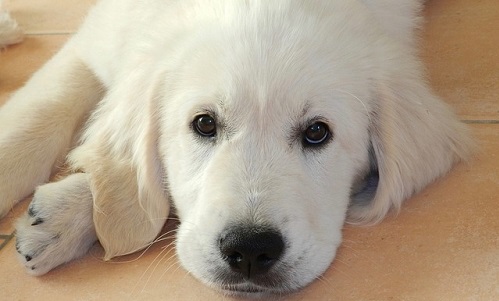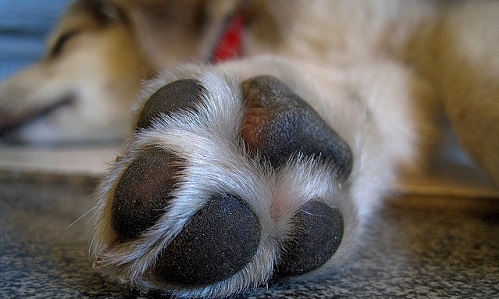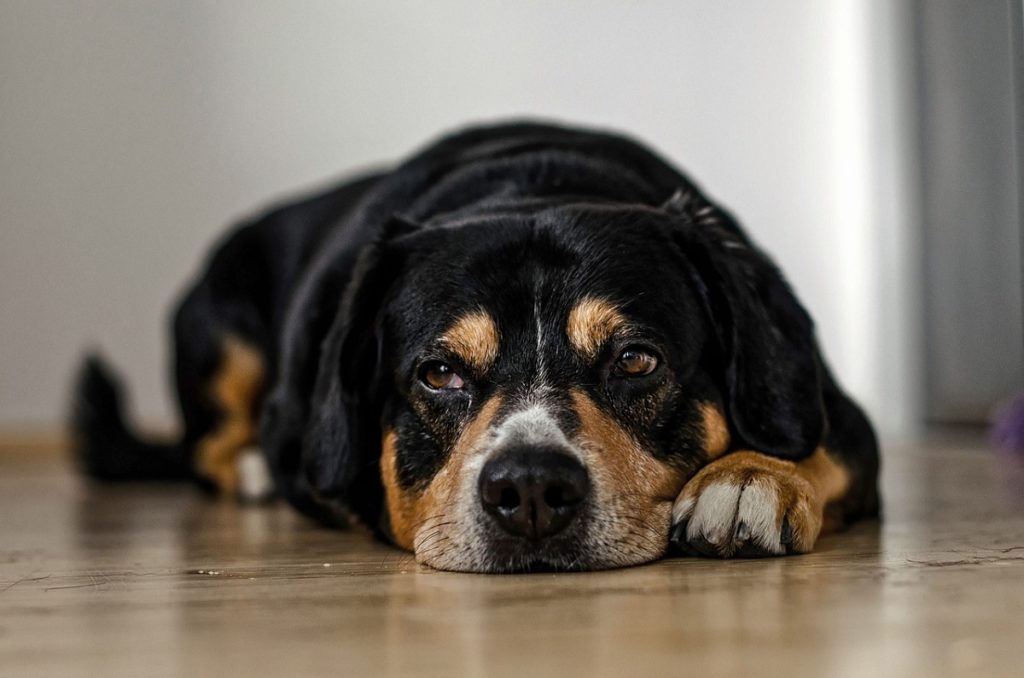Dogs have skin on their feet that is very different from the skin on human feet. It’s also very different from the skin elsewhere on a dog’s body. It is thick with a rubbery texture, providing padding and shock absorption for your dog’s leg bones and joints.
A dog’s paw pads also help protect their feet from extreme weather conditions and rough terrain. Because the skin of a dog’s foot pad is not like the skin that is found elsewhere on a dog’s body, it also doesn’t heal in quite the same way if your dog suffers any sort of injury.
In fact, wounds or injuries to a dog’s paw pad can often take longer to heal than wounds found elsewhere on the body because paws can be more sensitive, especially in between the toes. Moist skin takes longer to heal, which makes recovery challenging. Also, because of the pressure placed on the foot when a dog tries to walk or run before the wound is fully healed, paw pad injury runs a higher risk of reopening and possibly getting infected.
If you notice any symptoms such as limping, refusing to walk, favoring a certain leg, or sudden licking and chewing of the feet in an obsessive manner, it’s possible your dog has cut or otherwise injured his paw somehow.
Types of Paw Pad Injuries in Dogs
A dog can injure their paw pad in numerous ways. Injuries to a dog’s paw pad range from blisters and abrasions, to pressure callus formations, to ulcers, burns, avulsions, lacerations, and more.
Additionally, because the paw pad is made from a different type of skin and tissue, it serves very specific and distinct functions for your dog. This means you can’t just replace the skin of the paw pad with skin from elsewhere on the body. This is why when a dog injures their paw pad, the goal of your vet is to preserve as much of the tissue of the paw pad as possible so that your dog has the best chance at a full recovery.
Burns and Blisters to a Dog’s Paw Pad
When a dog suffers burns or blisters to the paw pad, it’s usually either from heat or from a chemical reaction. Dogs can also get frostbite, which can affect both the paw pad and their toes. Sometimes, dogs suffer from allergic reactions to something they come into contact with. The allergen may cause the skin on their feet to itch and their paw pad to swell. You may also notice your dog licking and chewing at their feet compulsively in an effort to alleviate the irritation, which is often a strong indicator your dog has some sort of allergy.
Abrasions to a Dog’s Paw Pad
Sometimes dogs suffer from abrasions. Abrasions are where an area of a dog’s skin has been worn or scraped away, including the skin of their paw pad. It happens often when a dog plays or runs on a surface that is rough and tough on their feet. Dogs can also suffer from a secondary fungal or bacterial infection as a result, or a parasite infestation, both of which require a visit to the vet and possibly medication.
Lacerations to a Dog’s Paw Pad
 Dogs can suffer from lacerations too. A laceration occurs any time the skin is cut, torn, or punctured. Puncture wounds and lacerations that a dog receives in the pad of their paw can be deeper than you might realize. They could possibly hide a foreign object too, so be sure to inspect your dog’s paws carefully to make sure there is nothing hidden that could cause additional injury.
Dogs can suffer from lacerations too. A laceration occurs any time the skin is cut, torn, or punctured. Puncture wounds and lacerations that a dog receives in the pad of their paw can be deeper than you might realize. They could possibly hide a foreign object too, so be sure to inspect your dog’s paws carefully to make sure there is nothing hidden that could cause additional injury.
A dog can receive lacerations or cuts from anything sharp, such as metal or glass. You can also look for things like thorns, nails, or burrs that may be embedded in the skin. Dogs can even cut their feet on sharp rocks or lawn edgings!
Treating a Cut on Your Dog’s Paw Pad
Treatment and management of the wound will depend on how deep the laceration is and how much tissue has been lost. Lacerations on a dog’s foot run a high risk of contamination and infection as well as re-injury, because dogs will continue to put their foot down on the ground and put pressure on the wound.
Unfortunately, this means your dog’s foot experiences almost constant friction. It also means it may be difficult to keep clean, opening it up to all sorts of possible infection. Dogs like licking wounds on their feet too, which can introduce additional contaminants and delay the healing process even more.
Step One
If you think that your dog has cut or has lacerated his foot somehow, the first thing you should do is wash it thoroughly with a good antibacterial soap. Use warm water and gently clean the pad so that the wound is visible and ready to be treated.
Step Two
The next thing you should do is visually inspect your dog’s paw. If you think something is stuck in the paw pad, you can try dipping the dog’s paw in a mixture of water and Epsom salts and allow it to soak for 15 minutes or so to soften up the skin and loosen any debris.
Step Three
Once you’ve done that, inspect the paw pad again, and if you can now see what is lodged in your dog’s foot, you can try to remove it using tweezers. Just be careful. If it doesn’t come free easily with the tweezers, leave it alone.
Step Four
Once you have cleaned your dog’s paw pad and let it dry, use a cotton ball soaked in betadine to disinfect the wound. You can also use a 50/50 solution of water and hydrogen peroxide if that’s more readily available to you. Let your dog’s foot air-dry completely.
Once the cut has been disinfected, you can then use an antibiotic ointment like Neosporin to help prevent any infection. Thankfully, Neosporin is safe for dogs to lick, which is good because for some reason they really enjoy doing so. However, the goal is to get the medication to absorb into the wound and to keep the cut dry, so discourage them from licking it if you can.
Step Five
If necessary, wrap your dog’s paw in a loose bandage so the medicine can do its work. If you decide to wrap your dog’s paw, the best way to do it is to use gauze and create a small bit of cushion under your dog’s paw pad.
Then use paper tape or a bandage that self-adheres to hold the gauze to the foot and keep it from coming off. It’s best to wrap or tape the bandage just above your dog’s next leg joint, so you can keep it from slipping off. Just don’t make the bandage too tight or you risk cutting off his circulation. You should leave roughly two fingers’ worth of space in between your dog’s skin and the bandage.
How to Keep Your Dog from Eating Their Paw Pad Bandage
If your dog tends to eat things he shouldn’t, watch him like a hawk because he could very well decide to eat his bandage, rendering all your prior efforts at keeping the wound clean and protected null and void.
Occasionally, if your dog is resting or napping you can try removing the bandage to allow the wound to get some fresh air, as this will help it to heal more quickly. Just strive to keep it bandaged when your dog is up and moving about so it’s protected from bacteria and infection.
If your dog likes to eat things he shouldn’t, you could try using a sock on top of the bandage to keep him from chewing and licking at it. Only do this if you are keeping your canine under a watchful eye though because some dogs will even eat the socks! Since socks can cause an obstruction in a dog’s intestine, this can be very dangerous to their health.
Some pet owners have found success using a bitter apple spray to make their dog’s bandage or sock taste bad. It’s good discouragement for most dogs to keep them from chewing and licking a bandage but keep in mind, it doesn’t work for all dogs. Some dogs chomp away and pay no mind to the terrible flavor.
Also, make sure you never spray bitter apple on the wound itself, only the bandage. Another alternative is to try distracting your dog with bones and chew toys, especially if they are easily bored and like to pick at their feet. Again, this is a tactic that can be helpful, but it really depends on the dog. The reality is that it doesn’t always work with every dog.
 If worse comes to worst and your dog still simply won’t stop licking and chewing at their paws, you can try placing a cone collar on them. Cone collars are shaped like a lampshade and are designed to keep dogs from being able to chew or lick at areas that are injured.
If worse comes to worst and your dog still simply won’t stop licking and chewing at their paws, you can try placing a cone collar on them. Cone collars are shaped like a lampshade and are designed to keep dogs from being able to chew or lick at areas that are injured.
Dogs don’t typically like these collars much, so you may notice them mope around a bit at first. Eventually, they will get used to it and perk back up, just be patient.
Ultimately, if there is a cut on a dog’s paw pad, it needs to be monitored almost constantly in order for the wound to heal properly. This is especially true during the nighttime hours. Whether it’s because your dog is simply awake and bored, or because they know at night you are sleeping and therefore not supervising him, a dog seems more prone to chewing and licking in the dark. If you’re a light sleeper, you might try kenneling them in your bedroom for the night so that you can hear the smacking and stop them when they think they are being sly.
Preventing Cuts on Your Dog’s Paw Pad
Prevention is always the best medicine. You can help prevent injuries and problems with your dog’s paws in general by keeping their nails trimmed on a regular basis. This not only helps prevent your dog from developing ingrown toenails, it also helps them to keep their feet properly aligned and improves their traction.
Don’t force your dog to walk on rocky terrain without some kind of foot protection and don’t make them walk on hot or cold surfaces in extreme weather conditions without doggie boots. A great rule of thumb is to ask yourself whether or not you would walk on it barefoot. If you wouldn’t, you definitely shouldn’t make your dog do it.
You can also moisturize your dog’s footpads, especially if you live in dry climates or the weather is experiencing a particular dry season. This can help protect them and prevent issues like cracked dog paw pads, hotspots, and cuts. Remember to check your dog’s paw pads often for any possible injuries or damage, especially if they have been outside for a while or have been exploring a new territory.
If you have any doubts or worries at all about treating a cut on your dog’s paw pad appropriately, or if your dog’s paw bleeds profusely and doesn’t seem to stop, you should see your vet right away. It’s always better to be safe rather than sorry.
Then you can leave the treatment of your dog’s injury to the professionals and spend your time showering your four-legged friend with love and reassurance instead.




